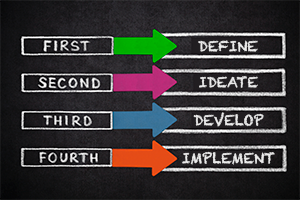September 15
– Filing deadline for 2022 calendar-year S corporation and partnership tax returns on extension
– Due date for 3rd quarter installment of 2023 estimated income tax for individuals, calendar-year corporations and calendar-year trusts & estates
Preventing unwanted tax surprises starts with proper planning. And there’s no better time than now to begin looking at how you can cut next year’s tax bill. In this month’s newsletter, we’ve included several situations when it makes sense to schedule a tax review so you can try and avoid a future tax surprise.
Also read about several ideas for mastering your credit card, tips to lower the cost of your auto insurance, and how you can become a better problem solver.
As always, please feel free to pass this newsletter to anyone who may find it valuable and call if you have any questions or concerns.
When to Call: Common Situations that Require a Tax Review

Taxes can affect many areas of your life. Here are some common situations when you’ll want to schedule a tax review.
- Something changed in your life. A change in your life could mean significant changes in your tax status. Some of these changes include:How your taxes may be different: Tax deductions and credits can increase and decrease because of these and other life changes. You’ll want to know as soon as possible if your taxes will be going up so you can be prepared to pay the increased amount.
- Getting married or divorced
- Retirement
- A child starting college or an adult going back to school
- Moving to a new home
- The birth of a child or an adoption
- A family member passes away
- A new job. You’ll have several decisions to make when starting a new job that will affect your tax situation:How your taxes may be different: You can decrease your taxable income by contributing to qualified retirement and medical savings plans. A tax planning session can reveal how much you can contribute to each of these plans, and if you should consider adjusting your paycheck withholdings.
- Retirement savings plans – Learn about the available retirement savings plans offered by the employer and any other tax-deferred savings options. Remember that some employers will match a certain percentage of contributions that an employee makes to a plan.
- Medical savings accounts – Your employer may offer a Flexible Spending Account or a Health Savings Account to help with paying certain medical expenses with pre-tax funds.
- Withholding – You’ll need to determine if you want additional federal (along with state and local income taxes if applicable) income taxes withheld from your paycheck beyond what your employer is obligated to withhold.
- A new business or side hustle. A new business (hopefully!) means more money, but also more tax responsibilities. Here are some things to consider:How your taxes may be different: Most small businesses are flow through entities. This means any business profits will add to your personal income. Because of this, your personal tax situation could vary dramatically! So tax planning becomes critical on two fronts: Your new taxable income level AND helping you stay in compliance at the federal, state and local business tax rules.
- Separate accounts and credit cards – If you only remember one tip, it’s to keep separate accounts. Without this, it is easy for the IRS to deem expenses as personal and, therefore, not deductible.
- Paying estimated taxes – As a business owner, you are responsible for making tax payments throughout the year to the IRS if your business is profitable.
- Setting up a bookkeeping system – Having an accurate bookkeeping system is vital to making sure you don’t pay any more in taxes than you’re legally obligated to pay. Consider reconciling your bank accounts weekly (or even daily if possible) so they’re always current.
- Other tax responsibilities – You may be required to submit a sales tax return depending on what types of products you sell or services you provide. You’ll also be required to submit various payroll tax returns if you have any employees.
Nobody likes a tax surprise and now is a great time to schedule a tax planning review.
Mastering Your Credit Card (and Not the Other Way Around!)

The average credit card balance in America ballooned to $5,910 in 2022. This figure is up 13.2% from the year before according to Experian, and it spells out a worrisome (and costly) trend for consumers. After all, credit card interest rates were on rise throughout all last year and well into 2023, mostly due to changes to the federal funds rate by the Federal Reserve. The fact is, consumers with credit card debt pay an average interest rate of 20.92% as of February 2023, compared to just 16.65% in the second quarter of 2022.
Fortunately, you have the power to use credit cards to your advantage — and to avoid paying exorbitant interest rates altogether. Consider these tips to master credit cards instead of letting them rule over you this year.
- Plan purchases to carry no credit card balance. While interest rates are incredibly high right now, you can use credit cards without paying for the privilege. Instead of racking up balances and hoping you can afford the bill, use credit cards for planned purchases only — and for spending that’s backed up by money in the bank. Provided you pay your credit card balance in full each month, today’s sky-high interest rates can’t hurt you.
- Consolidate high-interest debts. You can get a break from today’s high rates by consolidating credit card debt you already have with a 0% balance transfer credit card. Many cards in this niche give you 0% APR on balance transfers, purchases or both for up to 21 months. This gives you time to pay down your balance with zero interest, which can help eliminate debt faster and save money along the way.
- Earn rewards for your spending. If you’re still using your old credit card from college or haven’t bothered to upgrade in the last few years, you could be missing out. Today’s credit cards let you earn as much as 2% cash back on spending with no annual fee, or you can opt to earn generous rewards for travel instead. Just make sure you carry no balance, as interest rates on these cards can be even higher than regular credit cards.
- Put your perks to work. Finally, check whether your credit card has other, often unpromoted, benefits. Depending on your card, you may have access to perks like purchase protection against damage or theft, extended warranties on items you buy that come with a manufacturer’s warranty or even travel insurance protections. If you already have access to these benefits or others, knowing ahead of time is the best way to put them to good use.
Credit cards offer convenience and a range of features you can benefit from, but they can either be a blessing or a curse for your finances. Ultimately, your best bet is taking control of your credit card use before it controls you.
Thinking Differently: An Approach to Creative Problem Solving

Solving a difficult problem isn’t reserved for only the world’s greatest thinkers. Great creations are simply well-crafted solutions using organized, creative thinking. Here is a four step process so you, too, can become a great creative problem solver!
Step 1 – Define the problem
This step is the most critical. Albert Einstein once said, “If I were given one hour to save the planet, I would spend 59 minutes defining the problem and one minute resolving it.” Think about it – if you get this step wrong, it immediately puts you on the wrong track and all the work that comes after moves you further from the solution. In short, you want to understand as much about the issue as you can. Write down everything you know about the problem and related answers to define what you need to investigate. Summarize your thoughts into a single problem statement.
Step 2 – Ideate
Don’t overthink this step. The time and energy you put into defining the problem will create quite a few ideas, many of them unorganized, bouncing around in your brain. The goal is to take all these thoughts out of your brain and put them into writing. Don’t do any internal filtering – it all needs to come out. Brainstorming is all about quantity with no regard for quality. (Quality control will come later!) Think about it like starting a puzzle by first dumping all the pieces out of the box. If you left any in the box, you have no chance of completing the puzzle. The more out-of-the-box and abstract the idea, the better!
Step 3 – Develop your ideas
Once you have all your idea fragments written down, you’ll notice a few that rise to the top as possible solutions. Identify these top 3 to 5 solutions, then see if the rest of your brainstorming ideas can fit as a supporting detail with any of these main solutions. Now think through why each of these ideas might yield a solution and form a hypothesis as to how this idea will play out. From there, break apart the hypothesis and identify any potential flaws. Revealing possible weak spots is a great starting point to defining the pathway for a solution.
Step 4 – Implement your solution
This final step may seem daunting, but the key is to break the final project into as many bite-size steps as possible. The smaller and easier it is to manage, the better. Identify each step of the implementation process, write down the dependencies for each of these steps and connect them together to work towards the final solution. As you work through them, it’s important to stay flexible as unforeseen obstacles will arise and you need to be able to pivot.
Continue to work through your problem solving process, retesting and refining as you go. Odds are you’ll initially take some steps backwards, but don’t give up! The ability to stay resilient is as important as the process itself to reach your final goal.
6 Tips for Lower Car Insurance Rates

If you’ve been feeling the pinch of higher auto insurance rates along with other rising costs, you should know some factors that impact these rates are well within your control. Consider these tips to pay less this year and beyond.
- Improve your credit score. Many insurance companies consider your credit score and overall creditworthiness when assigning rates, mostly because their research shows credit scores directly correlate with how much risk you pose as a driver. This means that if you want to pay less for auto insurance coverage, you should strive to increase your credit score or move your policy to an insurer that does not use this factor in determining rates. Some easy ways to increase your credit score include using less than 20% of your credit line on your credit cards and by paying all your bills on time.
- Ask about discounts. Some auto insurance companies have discounts that are not actively promoted. These are often missed by long-time policy holders that do not specifically ask for them. Examples of discounts include lower rates for being a good student, driving fewer miles, purchasing a car with a lower claim history, or discounts for having air bags, anti-lock brakes, and theft detection devices. There are even discounts for federal employees, military members and for being accident-free for a certain number of years.
- Pay premiums in advance. Some auto insurance companies also offer pay-in-full discounts that let you save when you pay for six months or a full year of premiums upfront. This discount can result in 10% to 20% lower premiums right off the bat.
- Bundle multiple policies. You may be able to score a discount for having multiple types of coverage with a single insurance company, just as you may get a multi-vehicle discount for having more than one car insured. Typical bundled policies include life insurance, auto insurance, home insurance and umbrella coverage.
- Tweak your deductible. Your auto insurance deductible — or the amount you pay for certain claims before coverage kicks in — also plays a role in the cost you pay for auto coverage, and higher deductibles can lead to savings. With that in mind, check how your premiums change if you increase your deductible from $500 to $1,000, from $1,000 to $2,500, and so on.
- Take a safe driving course. Finally, taking a safe driving course can help lock in lower auto insurance premiums no matter your age or driving history. The amount of savings you’ll get with this discount can vary, so ask your insurer.
Auto insurance rates may not be going down any time soon, but the steps you take now can help you pay lower rates from this point forward. By improving your credit, checking for discounts and tweaking your policy details, you can get the coverage you need for a price you can afford.
